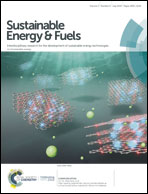Photoelectrochemical water vapor splitting using an ionomer-coated rutile TiO2 thin layer on titanium microfiber felt as an oxygen-evolving photoanode†
Abstract
Photoelectrochemical (PEC) decomposition of water at room temperature and separation of hydrogen and oxygen has been achieved using a solid-state cell with a proton exchange membrane (PEM). The PEM–PEC cell can use water vapor instead of liquid aqueous electrolytes for solar hydrogen production. In this study, we aimed to evaluate the performance of thermally oxidized rutile TiO2 layers on titanium microfiber felt for the photoanodic oxidation of water vapor in the gas phase. We investigated the effects of perfluorosulfonic acid ionomer coating, the wavelength and intensity of incident UV light, and external electric bias on the photocurrent density of TiO2 photoanodes in a humidified gaseous condition. The gas-phase PEC performance of the rutile TiO2 thin layer electrode was much higher than that of the anatase TiO2 nanotube array electrode under 385 nm UV illumination at high irradiance (40 mW cm−2). The H2 evolution rate in the PEM–PEC cell using a rutile TiO2 layer as an oxygen-evolving photoanode was 330 μmol h−1 under 385 nm UV (irradiation area 16 cm2) at an applied voltage of 1.2 V.



 Please wait while we load your content...
Please wait while we load your content...